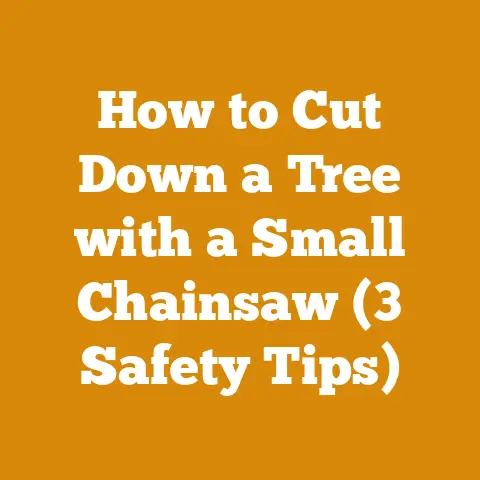Best Arborist Rope (5 Strong Choices)
When you’re up in a tree, the last thing you want to worry about is whether your rope will hold. Trusting your life to a good rope is a necessity. I’ve spent countless hours in the canopy, and I’m here to share my insights on the best arborist ropes out there. Let’s make sure you’re equipped with the right rope for your needs.
1. Samson ArborMaster
Samson ArborMaster is like an old reliable friend. It’s been around for a while and has a reputation for durability.
Features:
- Diameter: 12mm
- Length: Available in various lengths
- Material: Polyester cover with nylon core
This rope provides excellent grip and flexibility, making it ideal for climbing. I’ve used it plenty of times in different weather conditions, and it never let me down.
Why I Recommend It:
- Durability: Resists abrasion and fraying.
- Knotability: Easy to tie and untie knots.
I remember using the ArborMaster during a particularly rainy season. Many ropes would have become slippery and unreliable, but this one held its ground.
In-Depth Benefits:
Samson ArborMaster’s construction is designed to withstand repeated use without losing its integrity. Its polyester cover protects the nylon core, ensuring the rope remains strong even after prolonged exposure to the elements. This makes it an excellent choice for arborists who frequently work in variable weather conditions.
Personal Experience:
One memorable climb involved pruning a large oak tree that had been struck by lightning. The tree’s structure was compromised, making it a challenging and risky job. With the ArborMaster rope, I felt secure as I navigated the unstable branches. Its flexibility allowed me to maneuver smoothly, and its durability gave me confidence that it wouldn’t fail under pressure.
Additional Tips:
When using the ArborMaster rope, always inspect it for any signs of wear before each climb. While it’s known for its resilience, regular checks ensure that it remains in optimal condition.
2. Teufelberger Tachyon
The Tachyon rope from Teufelberger is another favorite of mine. Known for its light weight and high strength, it’s perfect for those who need something a bit more flexible.
Features:
- Diameter: 11.5mm
- Material: Polyester cover with nylon core
Why I Recommend It:
- Lightweight: Keeps fatigue at bay during long climbs.
- Versatile: Suitable for both climbing and rigging.
I recall a challenging climb where I needed to switch quickly between climbing and rigging. Tachyon made the process seamless, saving me both time and energy.
In-Depth Benefits:
With its low weight, Tachyon reduces strain on your body during extended climbs. This is particularly beneficial for arborists who spend long hours in the trees, as it minimizes fatigue and allows for greater focus on the task at hand.
Personal Experience:
During a multi-day job removing invasive species from a nature reserve, I relied heavily on my Tachyon rope. Its versatility allowed me to adapt quickly to different tasks, from climbing tall trees to rigging down large branches. The rope’s smooth handling made transitions effortless, enhancing both my efficiency and safety.
Additional Tips:
To maximize the lifespan of your Tachyon rope, store it in a cool, dry place away from direct sunlight when not in use. This helps preserve its materials and prevents premature degradation.
3. Yale Blue Moon
Yale Blue Moon stands out with its vibrant color and reliable performance. This rope has been a game changer for many arborists, including myself.
Features:
- Diameter: 11.7mm
- Material: Polyester cover with a double-braid construction
Why I Recommend It:
- Visibility: The bright color makes it easy to spot in dense foliage.
- Smooth Handling: Glides effortlessly through gear without snagging.
I once had to perform an emergency descent, and Blue Moon’s smooth handling ensured a fast and safe trip down.
In-Depth Benefits:
Blue Moon’s double-braid construction enhances its strength and durability, allowing it to withstand heavy loads without compromising safety. Its vibrant color not only aids visibility but also adds an element of safety by reducing the risk of accidental cuts or damage.
Personal Experience:
While working on a complex tree removal near power lines, Blue Moon’s visibility was crucial. The bright hue helped me quickly identify my position relative to the hazardous lines, allowing me to navigate safely and efficiently without unnecessary risks.
Additional Tips:
Consider using gloves when handling Blue Moon rope to maintain a secure grip and prevent blisters during prolonged use. This ensures both comfort and safety throughout your climb.
4. Sterling HTP Static
If you need a rope for static applications, Sterling HTP Static is the way to go. It’s perfect when stability is your priority.
Features:
- Diameter: 11mm
- Material: 100% polyester
Why I Recommend It:
- Low Stretch: Ideal for hauling or rappelling.
- Resilience: Withstands harsh environmental conditions.
I frequently use this rope for hauling equipment up trees. Its minimal stretch guarantees that my load stays steady.
In-Depth Benefits:
Sterling HTP Static’s low-stretch design ensures precise control during tasks that require stability, such as hauling heavy gear or performing technical rescues. Its resilience in extreme conditions makes it suitable for use in challenging environments where reliability is paramount.
Personal Experience:
During a winter storm cleanup operation, I relied on my Sterling HTP Static rope to haul large branches safely to the ground. Despite icy conditions, the rope maintained its grip and stability, allowing me to complete the task efficiently and without incident.
Additional Tips:
Regularly inspect your Sterling HTP Static rope for signs of wear or damage caused by abrasive surfaces or extreme temperatures. Promptly address any issues to maintain its performance and longevity.
5. New England Ropes Safety Blue
A classic choice among arborists, the New England Ropes Safety Blue is known for its dependability.
Features:
- Diameter: 12mm
- Material: Polyester cover with a polyolefin core
Why I Recommend It:
- Safety: The blue core acts as a wear indicator.
- Comfortable Grip: Easy to handle even without gloves.
On one occasion, I noticed the blue core peeking through just before a major climb—alerting me to replace it just in time.
In-Depth Benefits:
Safety Blue’s innovative wear indicator provides an extra layer of safety by allowing you to visually assess the rope’s condition at a glance. Its comfortable grip enhances handling, reducing hand fatigue during extended use.
Personal Experience:
I once had to perform an emergency rescue of an injured colleague stranded mid-climb. The Safety Blue rope’s wear indicator gave me peace of mind knowing that I was using reliable equipment during such a critical situation.
Additional Tips:
Keep an eye on the wear indicator regularly to ensure your Safety Blue rope remains in optimal condition. Replace it promptly if signs of wear become visible to maintain safety standards.
Prerequisites and Required Materials
Before heading up, make sure you have the following:
Prerequisite Knowledge:
- Understanding of basic knot tying
- Familiarity with climbing techniques
Required Materials:
- Harness
- Helmet
- Carabiners
- Climbing spurs (if needed)
Additional Equipment:
For more advanced tasks or longer climbs, consider equipping yourself with additional tools such as ascenders, descenders, prusik loops, and lanyards. These tools enhance your climbing capabilities and provide greater versatility when working at height.
Safety Precautions
Always double-check your knots before climbing. A loose knot can spell disaster.
Use a helmet to protect yourself from falling debris or accidental bumps.
Inspect your ropes regularly for signs of wear and tear. Replace them as soon as you see any damage.
Never climb alone. Always have a partner nearby in case of an emergency.
Additional Safety Measures:
- Conduct a thorough inspection of all equipment before each climb.
- Maintain clear communication with your team members throughout the operation.
- Be aware of weather conditions that may impact safety or visibility.
- Ensure all climbing gear is properly fitted and adjusted for comfort and security.
Common Questions and Concerns
What length of rope do I need?
It depends on the height of the trees you usually climb. Typically, a 150-foot rope should suffice for most climbs.
How often should I replace my rope?
Check your ropes regularly for signs of wear. If the sheath is damaged or there are visible signs of weakening, replace it immediately.
Can I use these ropes for other activities?
While these ropes are designed for arborist work, some may be suitable for other applications like rescue operations or recreational climbing. Always check the specifications first.
Are there specific weather conditions that affect rope performance?
Yes, extreme temperatures, moisture, and UV exposure can impact rope performance over time. Ensure your ropes are stored properly when not in use to minimize these effects.
Troubleshooting Tips
Problem: Rope feels slippery during climbs. Solution: Ensure it’s clean and dry before use. Consider wearing gloves for a better grip.
Problem: Rope tangles easily. Solution: Coil your ropes properly after each use to prevent tangles.
Problem: Knots are difficult to untie. Solution: Practice different knot techniques that allow easier untying without compromising security.
Advanced Troubleshooting:
If you encounter persistent issues with your ropes despite following best practices, it may be beneficial to consult with experienced arborists or attend workshops on advanced climbing techniques for additional insights and guidance.
Important Reminders
Stay vigilant about safety checks and equipment maintenance. Your life might depend on it someday. If you’re unsure about anything, ask an experienced arborist or attend a training session.
Final Thoughts:
Investing in high-quality ropes is essential for both safety and performance as an arborist. By choosing reliable options like Samson ArborMaster, Teufelberger Tachyon, Yale Blue Moon, Sterling HTP Static, or New England Ropes Safety Blue—and adhering to proper usage protocols—you’ll ensure successful climbs while minimizing risks associated with working at height.
FAQ
Are these ropes suitable for beginners?
Yes, but beginners should focus on learning proper techniques before attempting complex climbs.
What’s the best way to store ropes?
Store them in a cool, dry place away from direct sunlight to prevent damage.
How do I clean my ropes?
Use mild soap and water, then air dry them completely before storing away.
Can I use these ropes interchangeably for climbing and rigging?
While some ropes are versatile enough for both applications (like Teufelberger Tachyon), it’s crucial always verify their specifications beforehand so you’re using appropriate gear tailored specifically towards each task type involved within any given operation context!
Stay safe out there—and happy climbing!






